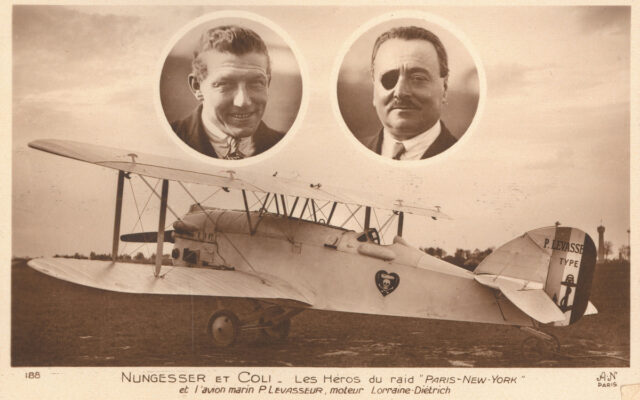
Discovery show tries to find famous missing plane in Maine’s woods
By Emily Burnham, Bangor Daily News Staff
Maine aviation history expert Peter Noddin spent a few days last summer exploring an area Down East for evidence of the wreckage of one of the most famous plane disappearances in history while filming an episode of a Discovery Channel program.
“Expedition: Unknown,” an adventure program hosted by Josh Gates, focused an episode on L’Oiseau Blanc, the White Bird, a plane piloted by two French aviators who hoped to become the first to fly across the Atlantic Ocean in 1927, weeks ahead of Charles Lindbergh.
The plane disappeared — supposedly somewhere between Newfoundland and Maine — and it has since become one of the great aviation mysteries of all time, right alongside Amelia Earhart’s crash and the fate of Malaysian Airlines Flight 370. Countless theories have arisen over the years as to where the plane may have crashed in 1927.
Noddin has searched the Maine woods for more than three decades trying to find any evidence of the White Bird. Along with other members of Maine’s aviation history community, he’s searched a number of areas in Down East, where it’s believed the plane may have crashed.

THE WHITE BIRD – Postcard of the White Bird, a French biplane which disappeared in 1927, during an attempt to make the first non-stop transatlantic flight between Paris and New York. The aircraft was flown by French aviation World War I heroes Charles Nungesser and Francois Coli.
“I’ve received literally hundreds of leads from all over the state, most of which are a bit nutty,” Noddin said. “But we’re focusing on the real evidence that we have, that was collected from people who actually heard or saw what very well may have been the plane.”
An initial segment on the episode detailed the history of White Bird aviators Charles Nungesser and Francois Coli, the French pilots who in the 1920s hoped to capture the Orteig Prize, which would be awarded to the first people to fly from Paris to New York. The pair took off from Paris on May 8, 1927, laden with so much fuel that they had to jettison almost everything on the plane — including the radio.
At some point, the plane disappeared. For decades, it was believed that it crashed into the Atlantic Ocean, but investigators such as Noddin believe it may have crashed in the woods in either Newfoundland or Maine.
In the episode, Noddin lays out his case as to why he believes the White Bird crashed in Maine. His biggest evidence is the fact that several people in Washington and Hancock counties saw a plane fly overhead in a southeasterly direction. In the 1920s, planes flying over rural Maine were an incredibly rare occurrence, meaning that it’s entirely possible the plane they saw was the White Bird.
There’s also the fact that in the 1950s, 30 years after the plane disappeared, a group of hunters that were out near Tunk Lake in Sullivan reportedly found what appeared to be debris from a plane wreckage, as well as what could be a human tibia, though according to Noddin they did not take any evidence from the site. It’s not known, however, exactly where those hunters were — only that they were on a hill, and that there was a geodetic survey marker nearby.
On “Expedition: Unknown,” Noddin and fellow wreck hunter James Chichetto of Hermon were joined by host Gates to search near Tunk Lake, finding the survey marker and then scanning the area with metal detectors. They actually come across a heavily rusted piece of metal with white paint on it, and then discover a piece of an airframe from an old plane — though they quickly determine that that wreckage was actually from a Canadian mail plane that went down around 1930.
Despite their turning up no evidence of the White Bird, Noddin said that finding any evidence of any sort of plane crash is still a thrill for him.
“It might not be an incredible find like the White Bird, but it’s still a piece of history,” Noddin said, who has found airplane wreckage in sites throughout Maine and is presently working on trying to find a Cessna float plane piloted by a Maine Guide named Fred Corrow, which disappeared near Moosehead Lake in 1969.
From there, the episode moves on to another search in Newfoundland, where Gates connects with another aviation history expert to try to find the White Bird wreckage again in an isolated pond near the island’s western shore — though they again come up short.
The episode first aired on June 15 and it can be watched anytime on the Discovery+ streaming platform.
Noddin said he hopes shows like “Expedition: Unknown” help get the next generation of treasure hunters, plane and ship wreck searchers and other adventurers into the world of solving historical mysteries.
“There are still so many mysteries to be solved, and I think shows like this help get people excited about what might be out there,” Noddin said. “It really shows how cool and interesting it all is and how much is still unknown out there.”